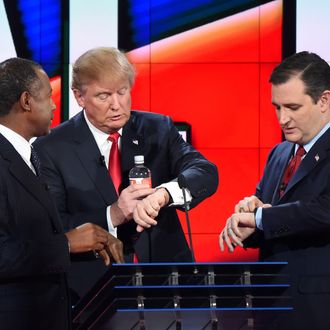
The convoluted nature of the 2016 GOP presidential nominating contest, and the (initial) size of the field, has given fresh hope to pundits who for occupational reasons quadrennially fantasize about a “brokered convention,” or at least a primary season that lasts longer than winter snow. But along comes nominating-contest wizard Josh Putnam to make the compelling case that we should know the identity of the nominee when the primary returns roll in on March 15.
Interviewed by the Washington Post’s Chris Cillizza, Putnam (who teaches at the University of Georgia) calls attention to what he calls the “50/75 rule”: For all the differences in the nominating contests of 2008 and 2012, the candidate who led in delegates when half had been awarded formally nailed down the nomination more or less when three-fourths had been awarded. In the abbreviated primary battle of 2008, the 50 percent mark was reached on February 8. The leader then, John McCain, did indeed win the nomination by March 4, when 75 percent of all delegates had been allocated. In the more stretched-out calendar of 2012, Mitt Romney led at the 50 percent mark on March 24, and actually didn’t formally croak Rick Santorum until a week after the 75 percent mark on May 22.
This year, a later start but a more compressed calendar has created yet another timetable for operation of the 50/75 rule: 50 percent of the delegates will have been awarded on March 15, and 75 percent on April 26, according to Putnam’s calculations.
Precedent aside, there’s a certain intuitive logic to the ides of March being the crucial date for Republicans. We’ll know by then, obviously, whether Donald Trump has been cut down to size by Ted Cruz in Iowa and by some Establishment candidate in New Hampshire. South Carolina, a traditional winnowing state, will have come and gone, as will have “Super Tuesday” on March 1, with its subtext of an “SEC Primary” of seven southern states where either Trump or Cruz — whichever has survived in good shape — could do very well. And on March 15 itself, there are five sizable states — Florida, Illinois, Missouri, North Carolina, and Ohio — holding primaries, with two of them (Florida and Ohio) awarding delegates on a winner-take-all basis. Florida alone could be either a landmark victory vaulting one of them into the lead or a death knell for Floridians Marco Rubio and Jeb Bush.
You can still construct scenarios where the contest stretches beyond the 75 percent mark in late April: if, for example, Trump is the leader and a well-funded ABD (Anybody But Donald) movement emerges. Or if Ted Cruz takes a solid lead by March 15, the shift in the calendar to northeastern states in April could slow down if not reverse his momentum. But no one should hock the family silverware to pay for accommodations in Cleveland in the expectation of an old-fashioned multi-ballot convention. That’s still at best a very remote possibility.






























